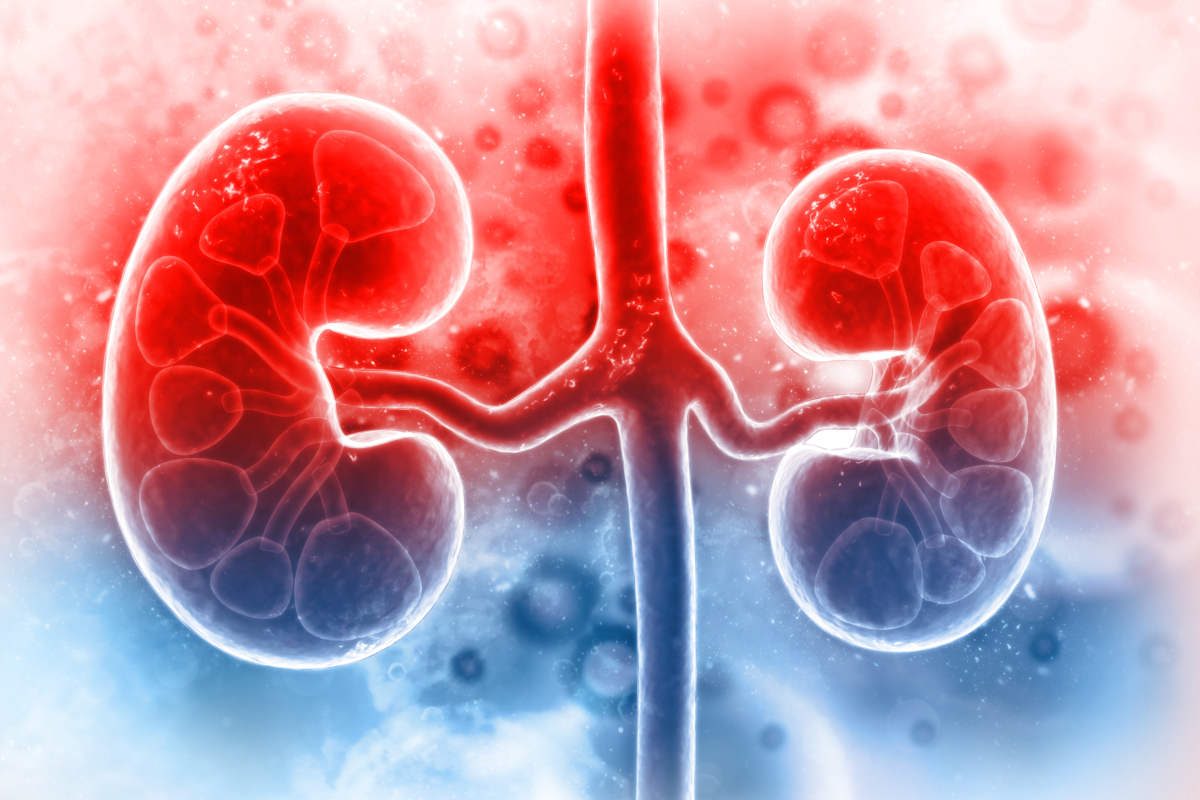In order to understand chronic kidney disease (CKD), we first need to think about how the kidneys maintain homeostasis.

Some vital functions of the kidneys are listed below:
1. Excretion of excess/harmful substances (e.g. drugs!)
2. Regulation of fluids, electrolytes, and blood pressure
3. Secretion of:
- Renin (part of the renin angiotensin aldosterone system- RAAS)
- Erythropoietin (for RBC production in the bone marrow)
- Active Vitamin D (calcitriol)
CKD is a progressive loss of kidney function that occurs over time (months to years).
The basic pathophysiology occurs as follows:
- Nephrons become enlarged in order to compensate for gradual loss of mass & function
- This leads to vascular damage and activation of RAAS
2. Angiotensin II = vasoconstriction (to maintain proper perfusion) = glomerular capillary hypertension (HTN)
3. Proteinuria: kidney damage leads to protein spilling into the urine (urine albumin used as a marker)
Patients with CKD may experience edema, shortness of breath, fatigue, loss of appetite, palpitations, muscle pain/cramps, among other symptoms.
I will outline the most common complications of CKD, the non-pharmacologic treatments, and the medications that are recommended for each. This is not an all-inclusive list, but rather a simplified and general guideline of how these complications are approached.
Fluid and Sodium Imbalances

In late CKD, the kidneys are unable to concentrate or dilute urine leading to sodium/H2O retention.
Patients often experience hypernatremia and hypervolemia (edema), which can worsen hypertension and congestive heart failure.

Hyperkalemia (High Potassium)
Normally potassium is filtered at the glomerulus and then reabsorbed or secreted as needed. However, in late CKD, there is decreased filtration AND secretion of potassium leading to hyperkalemia.
Because potassium plays a key role in the electric signaling of myocardium, it is important that we prevent/reverse cardiac abnormalities (e.g. arrhythmias).

Metabolic Acidosis

In CKD, the kidneys cannot make ammonia and therefore cannot properly buffer the urine. In addition, decreased renal acid excretion leads to metabolic acidosis!
Goals of therapy include normalizing the body’s pH and serum bicarbonate levels.

Anemia

About 90% of erythropoietin production occurs in the kidneys! As renal function decreases, the body is unable to compensate for this loss resulting in anemia, decreased hemoglobin levels, and iron deficiency.
Common symptoms of anemia include fatigue, shortness of breath, tachycardia, and tingling in the extremities.

- Goal for oral iron therapy = 200 mg/day
- IV iron supplementation is preferred in dialysis patients.
- Target hemoglobin = 9-11 g/dL because there is increased mortality risk (e.g. stroke) if we attempt to reach the normal range
Mineral Bone Disorder

The pathophysiology of mineral bone disorder (MBD) is complicated!
In early CKD, the body compensates for hyperphosphatemia by increasing PTH, which will increase calcium levels to bind/eliminate the phosphorus.
The calcium is quickly depleted and starts to leak from the bones.
Fibroblast growth factor-23 (FGF-23) is activated and increases phosphorus excretion, however this comes at the cost of Vitamin D deficiency.
In later CKD stages, we see chronic PTH elevation leading to secondary hyperparathyroidism.
Complications of MBD can include abnormal bone turnover, vascular calciphylaxis (Calcium-Phosphorus product deposits in small vessels), and even death.


- It’s important to first control phosphorus levels with phosphate binders before adding other therapies.
- Both Vitamin D and calcimimetics decrease PTH levels, however Vit D may lead to hypercalcemia whereas calcimimetics can lead to hypocalcemia.
Comorbid Diseases

Many CKD patients have multiple comorbidities, with diabetes and hypertension being both initiating and progression factors for CKD!
The main goal is to decrease the patient’s cardiovascular risk by controlling these diseases appropriately.
Non-pharmacologic therapy includes decreased sodium & cholesterol intake, regular exercise, smoking cessation, and weight loss.

Choric kidney disease is intricate and many patients face multiple challenges. Although each disease/condition is unique, it is important to analyze the patient’s overall clinical status so that appropriate and safe treatments can be recommended.
Pharmacists play a key role in the treatment of individuals with CKD. We provide patient education, identify drug-related problems, and prevent nephrotoxicity from medications.
It is important to support these patients long-term as their renal function declines, and collaborate with other health-care providers to provide the best care possible!
References
Please note that I learned about the diseases and treatments presented here during a pharmacy school course.
This content, and more, can be found in the Kidney Disease Improving Global Outcomes (KDIGO) and Kidney Disease Outcomes Quality Initiative (KDOQI) guidelines.
Please visit the links below for more information!


Be the first to reply